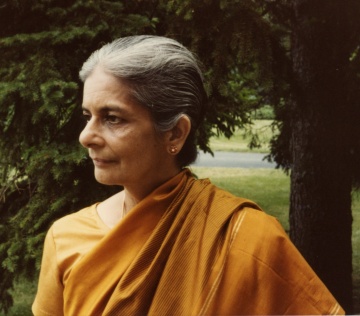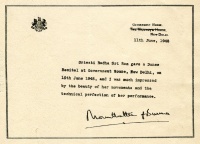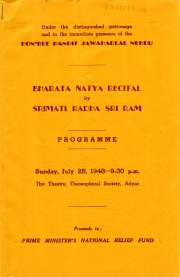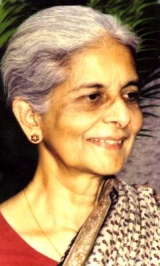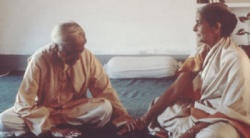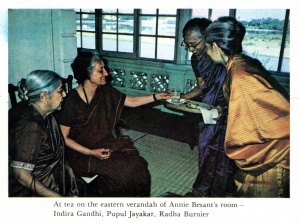Radha Burnier
Radha Burnier (née Radha Sri Ram) (November 15, 1923 – October 31, 2013) was the seventh international president of the Theosophical Society (Adyar). Having taken office in 1980, she was the longest standing president of the organization (33 years).
Early life and education
Radha S. Burnier, respectfully called "Radhaji", was born in Adyar, Chennai, India, on the grounds of the Theosophical Society (Adyar) on November 15 , 1923, into a Theosophical family. She was the daughter of Mr. Nilakanta Sri Ram, who was the fifth international president of the organization, and Srimati Bhagirathi, who was also an active member of the Society. Although she was born a Brahmin, her family did not follow the exclusivist customs attached to their caste but adhered to the Theosophical ideal of universal brotherhood.
Radha was a third-generation Theosophist. Her grandfather, A. Nilakanta Sastri, was an early member of the Society, much inspired by the Founders of the Society when they came to India and Madras.
As a child, she had the opportunity to make the acquaintance of Annie Besant, then president of the Theosophical Society, of which she kept some memories as an adult.
Radha was educated in the National Girls’ High School, which was founded by Annie Besant and other Theosophists. After Dr. G. S. Arundale started the Besant Memorial School, she joined it and completed her secondary school education. She then went to the Banaras Hindu University from which she obtained a B.A. with distinction and a M.A. on Sanskrit, standing first in that University. Later on, she would be awarded a doctorate in Sanskrit by this university for her contributions.
Early in 1951 Radha Sri Ram married Raymond Burnier, a Swiss photographer, who helped her begin a brief film career. He had come to India in 1932 to photograph temple art, and met young Radha at Hindu University in Benares. They were soon divorced.
Dance training
From 1938 to 1944 she studied classical Indian dance with her aunt Rukmini Devi Arundale at Kalakshetra, the Arts Academy that worked in the campus of the Theosophical Society. She was the first student to graduate in Bharata Natya from Kalakshetra and gave dance recitals in many cities in India and abroad.
The American Theosophist in May, 1942 reported this account from a member who visited Adyar:
We recently had the great privilege of attending a recital given by her [Rukmini Devi's] very best pupil, Shrimati Radha, Srhi Ram's daughter. It was a most perfect display of vital power, a thing only possible, I think, as a manifestation of inner possibilities and capacities. I myself have seen much of Oriental art, especially of dancing in Java, but never have I witnessed anything like this. A great future seems to lie in this work.[1]
Dance recitals
On July 10, 1948, Srimati Radha Sri Ram performed a dance recital at Government House in New Delhi for the Governor-General Lord Mountbatten and his wife and their assembled guests, including Prime Minister Jawaharlal Nehru and the diplomatic corps.[2] Lord Mountbatten wrote that he was "much impressed by the beauty of her movements and the technical perfection of her performance."[3]
A few weeks later, on the evening of Sunday, July 25, 1948, in the Theatre of the Theosophical Society headquarters at Adyar, Radhaji gave a Bharata Natya dance recital to benefit the Prime Minister's National Relief Fund. The Prime Minister, Pundit Jawaharlal Nehru, was present, along with his daughter, Mrs. Indira Gandhi; the Governor and Lady Nye; Srimati Bhagirathi Sri Ram, the dancer's mother; T.S. President C. Jinarājadāsa; T.S. Vice President Sidney A. Cook and his wife Etha; and many local dignitaries. At the end of the performance, Radha delivered to the Prime Minister a check for the Relief Fund, and he praised her dancing.[4][5]
Filming The River
Mrs. Burnier played a major role in the well-known director Jean Renoir’s classical film The River (Le Fleuve), based on Rumer Godden’s novel. The film was made in only five months, and was released in 1951. The producer, Kenneth McEldowney, made four trips to India in a year and a half, trying to cast the role of Melanie, because most Indian women were not permitted by their families to perform in a film, especially in a role that involved a kiss. When he met Radha, he was skeptical until he saw her dance. He said, “She was magnificent. She is like a goddess.” His wife Melvina wrote, “I never knew a goddess could have such a delightful sense of humor, such honest intelligence, such understanding of people and still be so young.”[6] Her family’s broad-minded view of culture permitted Radha to accept the film role.
Shortly after her marriage, the Burniers travelled to Beverly Hills, and then to New York with the Renoirs. She wrote in a letter to James S. Perkins,
You must have read in the papers about my marriage with Raymond Burnier whom you met in our house at Adyar. This, and other business connected with the film, have forced me to change my plans. We and the Renoirs and some other people are going to New York where we will see the colour-print of the film. . . I am extremely sorry that I will not be able to be present at the Convention. [7]
The film was well received and was influential to several Indian and American filmmakers. For an excerpt of Radhaji dancing, and the complete film, see the Videos section below.
During this time she met some famous people such us Charles Chaplin, with whom she shared a meal. Rahdaji was offered to participate in movies produced by Hollywood but declined the offer.
Theosophical work
Radha Burnier joined the Theosophical Society in 1935, when she was still 12 years old, and from 1945 onwards became actively involved with its various activities.
She was president of the Youth Lodge and Adyar Lodge for several years, and from 1959 to 1963 she was president of the Madras Theosophical Federation.
Besides her work as general secretary of the Indian Section and international president of the Theosophical Society (see below), she was a member of the Society’s General Council since 1960, a member of its Executive Committee since 1957, and a member of the Adyar Estate Administration Committee since its inception in 1960.
She was also the president of several Theosophical centers such as the Krotona Institute of Theosophy in Ojai, California, USA, The Manor in Sydney, Australia, and the International Theosophical Centre in Naarden, Holland.
Indian Section
From 1945 to 1951, while pursuing her studies at the Banaras Hindu University, she was active at the national headquarters of the Indian Section of the Theosophical Society in Varanasi (Benares), where she served as the Librarian.
In 1960 Mrs Burnier was elected as general secretary of the Indian Section of the Theosophical Society and stayed in office for eighteen years. During that time she lectured extensively throughout India and the world on Theosophical, philosophical and cultural subjects.
Adyar Library and Research Centre
From 1954 to 1959 she was the assistant director of the Adyar Library and Research Centre founded by Colonel Olcott. From 1959 until 1980 she was its Director. In this capacity, she was the editor of the Library’s Research journal Brahmavidyā and supervised its publications.
Mrs. Burnier translated several Sanskrit works, such as the Hatha-yoga-pradipika, a well-known manual on Hatha Yoga, and the chapter on dance in the Samgita-ratnâkara, a classic work on music and dance.
After being elected as international president of the Theosophical Society she continued to be on the editorial board of the Library’s annual journal on Indology.
President of the Theosophical Society
Mrs. Burnier was elected international president of the Theosophical Society (Adyar) on July 4 1980, and took office on July 17. She was eventually re-elected five times in that office. She was the seventh person to hold this office in the Society since it was founded in 1875, and was the longest standing President (33 years).
She presided over four World Congresses of the Theosophical Society: 1982 in Nairobi, Kenya; 1993 in Brasilia, Brazil, 2001 in Sydney, Australia; and 2010 in Rome, Italy.
While president, she frequently lectured all over the world. On three occasions she was asked to present the presitigious Blavatsky Lectures at the Theosophical Society in England. In 1979, her topic was "Self-Knowledge in the Light of Theosophy", published as "The Way of Self-Knowledge." In 1988 she spoke on "The Universal Yoga Tradition", and in 2005 it was "Living Truth: The Future of the Theosophical Society."
Radhaji's approach to Theosophy was that it should not be taken merely as a conceptual spiritual philosophy, but as a tool to produce a human regeneration. The wide and deep perspective of life and human beings that Theosophy offers is meant to give individuals the right perspective so that their actions can be wise and have a transformative effect.[8]
Although she was actively engaged in movements that worked on an external level to palliate the effects of suffering on human beings, animals, and the environment, she viewed the role of the Theosophical Society as having to do primarily with the inner, rather than the outer, challenge:
I think the work of the Theosophical Society is to point to the challenge within, because it is of much greater importance to see it and deal with it than to go on dealing with what is outside. If we do not look at the source of the problem, but only at the effects, then temporary, partial, and superficial solutions are found.[9]
To me it is clear that the main work of the T.S. is to point to the internal change and to help the world to deal radically with its problems. We must not become a group of people who are only interested in altering structures, systems, and methods. I am not saying that we should not participate in bringing about changes externally. But that cannot be the fundamental work of the Society.[10]
She frequently spoke about the need to produce a radical or fundamental change in the human being:
The fundamental change is therefore from selfishness, which is also self-centredness, self-preoccupation, and so forth, to a state of sympathy, harmony, and unity, where other people's well-being is realized to be of as much, if not more, importance than one's own.[11]
This change has to happen on an individual basis, but with an eye on the whole humanity. She stated that "Human society cannot change unless the individuals change, and the change must be in the direction of universality of outlook".[12]
Other activities
Mrs. Radha Burnier was involved in many cultural, educational, and spiritual activities and organizations.
She was the secretary of the Cultural Association of Varanasi, and supported the work of Beauty Without Cruelty, an animal rights movement based in India. Under her presidency the work of the Social Welfare Center and the Animal Dispensary at Adyar were vitalized.
Theosophical Education
While in Varanasi, from 1960 to 1972, Mrs. Burnier was the Manager of the Besant Theosophical School, and the Theosophical School, College, and Hostel for girls in that city.
She was chairman of the Olcott Education Society, Chennai, whose concern is the education and welfare of the underprivileged, and of the Besant Education Fellowship.
During her presidency the Olcott Memorial School, which was languishing, became known as one of the best schools for underprivileged children in the State of Tamil Nadu.[13]
Theosophical Order of Service
As part of her work as international president of the Theosophical Society (TS), Radha Burnier also became the head of the Theosophical Order of Service (TOS). The TOS is the service branch of the TS, putting into action the tenets of Theosophy. In this capacity, Mrs. Burnier provided support to the international secretary, Diana Dunningham Chapotin, who oversees the work of the TOS around the world. However, service had always been an important part of Mrs. Burnier’s life, whether it was the education of underprivileged children, the promotion of animal welfare, or the need for environmental awareness.
Her niece, Ananya Rajan, stated: "Throughout her life, Radhaji championed for those who could not speak, gave opportunities to those with little means, and personally helped a number of people using her own money anonymously".[14]
Co-Freemasonry
M. Ill. Bro. Radha Burnier, 33°, was the Most Puissant Grand Commander (MPGC) of the Eastern Section of the Order Le Droit Humain. In 2001, after a disagreement in the proceedings of the Order and its future, she founded the Eastern Order of International Co-Freemasonry. She was The Most Illustrious Grand Master (MIGM) of the Order as well as president of its Supreme Council from 2001 to 2013.
New Life for India Movement
The New Life for India Movement, whose aim is to create an awareness in Indian youth of right citizenship, right values and right means of livelihood, was started in 1968 under the leadership of Mrs. Burnier, who was then general secretary of the Indian Section. About this, international President, N. Sri Ram, reports in his Presidential Address of 1968:
Much of Dr. Annie Besant's work for India was aimed at the rehabilitation of India on a moral and spiritual basis . . . "keeping alight the torch of Spirit amid the fogs and storms of increasing materialism". Mrs. Burnier recalls these words, so that the Indian Theosophists at least may do all they can towards realizing the hope expressed by Dr. Besant.[15]
Meetings with religious and political leaders
Throughout her life, Mrs. Burnier met with many religious and political leaders in India and from all over the world.
Parliament of the World's Religions
In 1993, the Parliament of the World's Religions took place in Chicago, celebrating the centenary of the World's Parliament of Religions. Many religious leaders participated, including the Fourteenth Dalai Lama. Three major Theosophical organizations collaborated to present about 30 lectures and panel discussions. Mrs. Burnier spoke on "Self-Transformation and the Future of Religion."
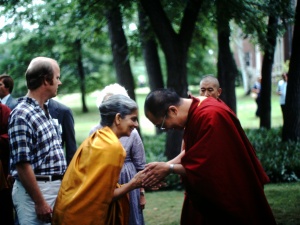
Dalai Lama
Mrs. Burnier met with Tenzin Gyatso, the XIV Dalai Lama several times during her presidency. One memorable occasion was in July, 1981, when His Holiness visited the Olcott campus of the Theosophical Society in America in Wheaton, Illinois. He gave a public lecture and a private talk to local members and staff, and stayed on campus for two nights.
Krishnamurti
Mrs. Burnier was a close associate of Jiddu Krishnamurti. They had known each other from the time he was a young man at Adyar and she was a child. This was due to the acquaintance between him and Radhaji's father, N. Sri Ram. Krishnamurti always treated her with much affection. In private conversations she recalled an instance in which young Krishnamurti gave her a tricycle as a birthday present and enjoyed watching her riding it.[16]
After he dissolved the Order of the Star in the East they lost contact for several years. Later, when she was a teenager, Krishnamurti recognized Radhaji in the audience at a talk he gave in Saanen. After the talk he sought after her and from that point on the two established a deep friendship.[17] Krishnamurti's teachings influenced and expanded much of Radhaji's own work and the need for personal open inquiry.
On November 4, 1980, a few months after she had become President of the TS for the first time, Krishnamurti visited Adyar at her invitation after an absence of 47 years. He walked with her and a number of residents from the main gate of the compound to the sea-shore and visited the beach where he was discovered in 1909 by C. W. Leadbeater. Two years later, in December 1982, during the Adyar Centenary Convention of the Theosophical Society, Krishnamurti planted a Bodhi tree at Adyar. After this, whenever he was in Madras, he would visit her house at Adyar and walk with her on the beach.
Mrs. Burnier was a trustee of the Krishnamurti Foundation India.
Indira Gandhi
Mrs. Burnier maintained a friendship with political leader Indira Gandhi. Mrs. Gandhi was good friends with Pupul Jayakar, who served on the arts commission for the Indian government and was closely associated with J. Krishnamurti. On January 2, 1983, Mrs. Gandhi gave the Besant Lecture at the International Headquarters in Adyar, entitled "The Future of Man", and published in The Theosophist, in April 1983.
During her stay Indira spent some time with Radhaji at her house having tea. She was impressed with the beauty of Adyar and the beach where Krishnamurti was discovered. Despite what people thought, there was a softer, inquiring side to Mrs. Gandhi that drew her to spirituality.
On November 1, 1984, Radhaji was to leave for Delhi to have lunch with Mrs. Gandhi. However, on the morning of October 31, Mrs. Gandhi was assassinated by her body guards while walking to her office. Ananya S. Rajan, who at the time was living at Adyar, wrote:
Everything shut down when the news spread that Mrs. Gandhi was killed. I remember coming home from college and my aunt was there, dressed in a white sari (the color for mourning). Her face was ashen gray and she seemed shaken. I never saw her look like that before. It was obvious she was deeply disturbed by the tragedy. Athai ["aunt" in Tamil] didn't attend the funeral, but we had a meditation for Indiraji at Headquarters Hall. Athai was very pulled in and quiet for a few days. I remember her sending Rajiv (Indira's son) a condolence letter as well as wishing him well for his new position as Prime Minister. Afterwards, she said to me, "It is a pity that you had not come earlier so you could have met her." This meant to me that despite Mrs. Gandhi's political career and decisions, Athai saw her as more than just a political head.[18]
Awards and honors
In January 1984, the Nagarjuna University conferred on her the Honorary Degree of Doctor of Letters in recognition of her "distinguished contribution to the advancement of learning and the promotion of human values".
On March 4, 2008, ChennaiOnline conferred the Golden Lotus Award on Radha Burnier at a function in Chennai, as a part of International Women's Day celebrations. Mrs Akhila Srinivasan, managing director in the Shriram Group, an insurance and finance corporation, presented this award, the citation, and a monetary award, honoring Mrs. Burnier's lifetime achievements.[19]
Personal tributes
In 1951, a friend asked,
"What do you want from life, Radha? Do you want to marry and have a family, do you want to have a career as a dancer or do you want to be a teacher? I think you could be anything you want to be. What is really your ambition?"
She answered me simply and directly as she always did: "My ambition is to perfect the art of self-discipline."
There certainly was nothing of the martyr or the fanatic in Radha. I understood clearly that she meant that we are only happy in life when we are strong, and we are only as strong as our weakness.”[20]
Writings
Mrs. Burnier served as editor of The Theosophist, and wrote many articles and editorials. The Union Index of Theosophical Periodicals lists over 960 published articles authored by Radha Burnier, in many major journals.
As a Sanskrit scholar, she collaborated in translating these texts:
- The Samgitaratnakara of Sarngadeva Vol. 4. Adyar, Madras, India: Adyar Library and Research Centre, 1976. This is Number 51 in the Adyar Library series, and Volume 4 is a chapter on dancing. Translators were K. Kunjunni Raja and Radha Burnier.
- The Hathayogapradipika: with the Commentary Jyotsna of Brahmananda and English translation. Adyar, Madras, India: Adyar Library and Research Centre, 1972. It is Number 4 in the Adyar Library Series. Translated by Radha Burnier and A. A. Ramanathan.
In addition, she wrote books, lectures, and booklets, some of which were translated into French, Spanish, Finnish, Dutch, and Slovenian:
- The Way of Self-Knowledge. Adyar, Madras, India: Theosophical Publishing House, 1979. Blavatsky lecture, delivered in 1979.
- D. K. Kunjunni Raja Felicitation Volume. Adyar, Madras, India: Adyar Library and Research Centre, 1982. Radha Burnier was editor of this festschrift for D. K. Kunjunni Raja.
- No Other Path to Go. Adyar, Madras, India: Theosophical Publishing House, 1985.
- Truth, Beauty and Goodness. Adyar, Madras, India: Theosophical Publishing House, 1985.
- The Universal Yoga Tradition. London: Theosophical Society in England, 1988. Blavatsky Lecture, delivered on July 30, 1988. Available at TS in America Website or TS in Australia Website.
- Beauty and Truth. Varanasi, India, 1900s.
- Human Regeneration: Lectures and Discussions. Adyar, Madras, India: Theosophical Publishing House, 1991.
- Masters and Gurus: Stages on the Path. Sydney: Education Unit, Theosophical Society in Australia, 2004. Theosophical study paper no. 4.
- The World Around Us. Adyar, Chennai, India: Theosophical Publishing House, 2009.
Death
Dr. Radha Burnier died in the evening of October 31, 2013, at her home.
On the morning of October 31, 2013, Radhaji woke feeling uncomfortable and unable to breathe. She was attended to by two doctors and given oxygen. She rested most of the day as she did not feel well. She was visited in the evening by the Vice-President Mahendra Singhal and his wife Shashi who, before leaving for Bali to attend the Indo-Pacific Conference in Radhaji's stead, had come for her blessing. She stated she was very happy they were going and wished them safe travels.
She seemed to know she was near the end of her life as she told the vice-president that she was going to have her overnight help sleep near her bed in case she passed. Around 9 p.m. she had an acute myocardial infarction (heart attack) and died peacefully at home.
After her body was prepared, she laid in state at Headquarters Hall in Adyar through the rest of the night until her cremation at 2 pm on November 1. Over 500 people (including the vice-president who cancelled travel plans) came to pay their respects as the news of her death became public. Radhaji's ashes were consigned to the Garden of Remembrance on the evening of November 1, as is tradition with Theosophical presidents, and to the Bay of Bengal.
Online resources
Articles
By Radha Burnier
- Various Articles by Radha Burnier at KatinkaHesselink.net
- The Alchemy of Experience
- Being in the World, But Not of It
- Brotherhood is a Fact in Nature
- Clear Vision and Sane Living
- Conventions at Adyar
- Culture and Human Progress
- Delight as a Form of Yoga
- The Essential Work of the Theosophical Society
- Gentle Thoughts and a Gentle World
- In Tune With the Universe
- J. Krishnamurti, Theosophy and the Theosophical Society
- Krishnamurti and Theosophy
- Masters and Gurus
- The Middle Way
- New Light on Old Ideas
- Nothingness
- On the Watch-Tower about the Work of the TS
- Stages On The Path
- Strength or Weakness?
- Theosophy Is for Everyone
- The Universal Yoga Tradition
- The Urgency for a New Perspective
- Walking with Radha by Pedro Oliveira
- The Web of Life
- What is Our Priority?
About Radha Burnier
- Radha Burnier at Theosopedia
- Radha S. Burnier at Theosophical Society Adyar website
- Conversations with Mrs Radha Burnier by Pedro Oliviera on CWL World web page.
- An Interview with Radha Burnier at Life Positive.com
- Press Release of the Grand Lodge of Freemasonry for Men and Women at KatinkaHesselink.net
- On the Watch Tower (about Radhaji's passing) by M. P. Singhal
- Radha Burnier Visits The Olcott Campus by Richard Smolley
- Theosophy loses a beloved daughter at The Hindu newspaper
- Her heart and soul were given to Theosophy at The Hindu newspaper
- Radha Burnier, president of Theosophical Society, dies at 90 at The Times of India
- Radha Burnier's Natal Chart at Khaldea.com
- "Theosophical Society president dies", MattersIndia website, November 1, 2013. Accessed November 3, 2013.
Audio
- The Basis of Meditation by Radha Burnier
- The Middle Way by Radha Burnier
Videos
- Radha Ji: Glimpses of Her Life and Influence by Pedro Oliveira. Lecture presented at The Indian Section Theosophical Society, Varnasi. Oct 30, 2020.
- "Radha Burnier of the Theosophic Society" YouTube interview.
- Presentation of the book The World Around Us by Radha Burnier
- Presidential Address Convention 2011 (Four Parts)
- Some Thoughts on the Work and Value of the Theosophical Society YouTube presentation of portrait to Radha Burnier by Tim Boyd.
- Death and Immortality lecture from the Theosophical Society in America.
- Radha Burnier dancing in Jean Renoir's "The River" (1951).
- Jean Renoir, The River (Le Fleuve), 1951. 1 hour, 35 minutes.
Notes
- ↑ Anonymous, "Vignette," The American Theosophist 30.5 (May, 1942), 118.
- ↑ "Mr. Sri Ram's Daughter Honored," The American Theosophist 36.9 (September, 1948), 215-216.
- ↑ Printed statement from Lord Mountbatten, July 11, 1948. Records Series 3.7. Theosophical Society in America Archives.
- ↑ "Attends Dance Recital," Adyar newspaper clipping, July 26, 1948. Records Series 3.7. Theosophical Society in America Archives.
- ↑ "Programme - Baharata Natya Recital by Srimati Radha Sri Ram." Records Series 3.7. Theosophical Society in America Archives.
- ↑ Melvina McEldowney, "I Have Met a Goddess," Western Family (March 8, 1951), 9.
- ↑ Letter from Radha Burnier to James Perkins. April 12, 1951. Records Series 3.7. Theosophical Society in America Archives.
- ↑ Radha Burnier, Human Regeneration (Amsterdam: Uitgeverij der Theosofische Vereniging in Nederland, 1990), 9.
- ↑ Radha Burnier, Human Regeneration (Amsterdam: Uitgeverij der Theosofische Vereniging in Nederland, 1990), 4.
- ↑ Radha Burnier, Human Regeneration (Amsterdam: Uitgeverij der Theosofische Vereniging in Nederland, 1990), 7.
- ↑ Radha Burnier, Human Regeneration (Amsterdam: Uitgeverij der Theosofische Vereniging in Nederland, 1990), 13.
- ↑ Radha Burnier, Human Regeneration (Amsterdam: Uitgeverij der Theosofische Vereniging in Nederland, 1990), 9.
- ↑ Radha S. Burnier at the Initernational Headquarter's website.
- ↑ Personal communication to Pablo Sender
- ↑ N. Sri Ram, "Presidential Address," The Theosophist vol 90:issue 4 (January, 1969), 217.
- ↑ Radha Burnier personal conversation with Pablo Sender.
- ↑ Reported by Ananya Rajan
- ↑ Ananya Rajan, personal communication to Pablo Sender
- ↑ The Hindu March 5, 2008. Available in online edition.
- ↑ Melvina McEldowney, "I Have Met a Goddess," Western Family (March 8, 1951), 44.
